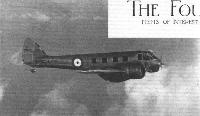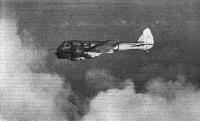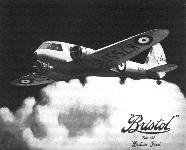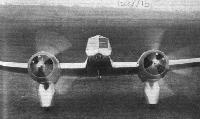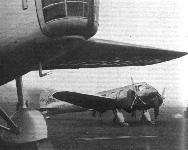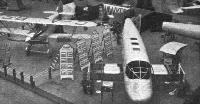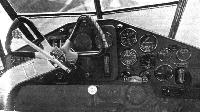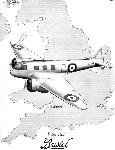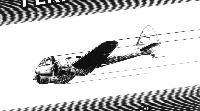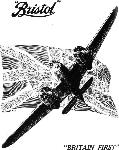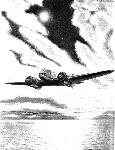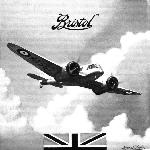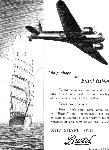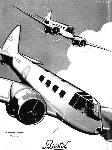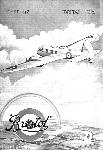
Варианты
- Bristol - Type 142 Britain First / Type 143 - 1935 - Великобритания
- Bristol - Blenheim - 1936 - Великобритания
- Bristol - Blenheim IV/Bolingbroke - 1937 - Великобритания
Type 142 Britain First / Type 143
В 1934 году владелец газеты "Daily Mail" виконт Ротермер решил приобрести для личного пользования новый корпоративный самолет. "Daily Mail" к тому времени уже много сделала для развития авиационного дела вообще и деловой авиации в частности. Основными требованиями Ротермера были высокая скорость, экипаж из двух человек и способность перевозить до шести пассажиров. Вскоре оказалось, что примерно такую конфигурацию имел проработанный в инициативном порядке специалистами компании "Bristol Aeroplane Company" легкий транспортный самолет. Силовая установка изначально предлагалась в составе двух двигателей Bristol Aquila I мощностью по 500 л.с, но, принимая во внимание требование Ротермера, Фрэнк Барнуэлл решил поставить два Bristol Mercury VIS мощностью по 650 л.с. В итоге появился Bristol Type 142, совершивший первый полет в Филтоне 12 апреля 1935 года.
Самолет превзошел все ожидания заказчика - он смог развить скорость на 48 км/час больше, чем у прототипа новейшего на тот момент британского истребителя. Самолету присвоили имя "Britain First", и Ротермер торжественно представил его общественности. Буквально тут же Министерство авиации решило взять самолет для испытаний - на предмет возможности его использования в качестве легкого бомбардировщика. Ротермер без колебаний подарил машину военным.
<...>
Описание:
- Type 142 Britain First / Type 143
- Flight, November 1934
THE FOURTEENTH PARIS AERO SHOW
Фотографии
-
Авиация и Космонавтика 2009-12 / В.Котельников - "СБ" по-английски /Самолеты второй мировой войны/
Регистрационный номер: K7557 [27] -
Flight 1936-04 / Flight Advertisements
Регистрационный номер: K7557 [27] -
Flight 1936-07 / Flight Advertisements
Регистрационный номер: K7557 [27] The Type 142 civil monoplane, Britain First, led to the production of the Blenheim. 1935
-
Flight 1936-06 / Flight
Регистрационный номер: K7557 [27] The machine is the Bristol 142 monoplane, which may be regarded as the precursor of the Blenheim medium bomber to be seen in the new-types park.
-
Flight 1936-02 / Flight
Регистрационный номер: K7557 [27] The prototype Bristol 142 (two 605 h.p. Mercury VI) from which a medium bomber is being developed.
-
Flight 1935-11 / Flight
Регистрационный номер: K7557 [27] FOR EXPRESS DELIVERY of just retribution and similar loads: The new Bristol 142 (two Bristol Mercury VI S engines), which is credited with a top speed of about 270 m.p.h. A modified version is being built as a medium bomber for the Royal Air Force Other aerial photographs of this noteworthy machine appeared in Flight last week.
-
Flight 1936-01 / Flight Advertisements
Регистрационный номер: K7557 [27] -
Jane's All the World Aircraft 1980 / Encyclopedia of Aviation - Aircraft A-Z - v2
Регистрационный номер: K7557 [27] Bristol Type 142 Britain First.
-
Aeroplane Monthly 1986-04 / ??? - Golden Anniversary
Регистрационный номер: K7557 [27] An evocative photograph of Britain First, the Bristol Type 142, K7557. After flying with the A&AEE the aircraft passed to the RAF where it became an instructional airframe with No 10 School of Technical Training at Kirkham, as 2211M. It was scrapped in 1944 by Morris Motors at Cowley.
-
Flight 1935-11 / Flight
Регистрационный номер: K7557 [27] COMING EVENTS .... The "shadow" in this case (seen above in the capable hands of Capt. C. F. Uwins) is the Bristol 142 medium bomber (two Bristol Mercury VI S engines). This is the actual machine recently presented to the Air Ministry by Lord Rothermere. A modified version is being built in large numbers for the Royal Air Force. With three-bladed variable-pitch airscrews and a retractable undercarriage this machine has been credited with a top speed of about 270 m.p.h. What the production model will do cannot be stated.
-
Мировая Авиация 149
Регистрационный номер: K7557 [27] Bristol 142 "Britain First", сфотографированный во время испытаний в Мартлешем-Хит в 1935 году, появился в результате частного заказа медиамагната лорда Ротермера и тут же вызвал интерес у военных.
OUTSTANDING 1935 MILITARY TYPE. From the Bristol 142 civil monoplane shown a high-speed medium bomber is being developed. In its civil form the 142, with two 605 h.p. Bristol Mercury VIs, does 268 m.p.h. -
Flight 1936-07 / Flight Advertisements
Регистрационный номер: K7557 [27] -
Flight 1935-08 / Flight
Регистрационный номер: K7557 [27] BRITAIN FIRST: The Bristol 140 civil monoplane, which has been presented to the Air Ministry by Lord Rothermere, coming in to land at Filton aerodrome. With two Bristol "Mercury" VI S engines the top speed is reputed to be in the region of 270 m.p.h.
-
Flight 1935-11 / Flight
Регистрационный номер: K7557 [27] The Bristol 142 Britain First, designed as a high-speed transport for Lord Rothermere, was the first twin to adopt VP propellers. The performance was so spectacular that the 142 was developed into the Blenheim bomber.
-
Flight 1936-07 / Flight Advertisements
Регистрационный номер: K7557 [27] -
Aviation Historian 1 / G.Warner - Why was the "Bristol" Mercury so long lived?
Регистрационный номер: K7557 [27] The sleek Bristol Type 142, named Britain First by Lord Rothermere, was powered by a pair of 650 h.p. Mercury VIs and made its first flight at Filton on April 12, 1935. From it came the development of the military Type 142M and the versatile Blenheim.
-
Flight 1935-11 / Flight
Регистрационный номер: K7557 [27] THE FLAPS of the Bristol 142. Another noteworthy point in this view is the amount of "visibility" surrounding the pilot.
-
Flight 1935-08 / Flight
Регистрационный номер: K7557 [27] HIGH SPEED: The clean lines of the all-metal Bristol 142 are obvious in this view, which also shows the trimming tabs on the rudder and ailerons.
-
Мировая Авиация 64
Регистрационный номер: K7557 [27] 12 апреля 1935г.: лорд Ротермер заказал самолет Bristol Type 142 в качестве высокоскоростного транспортника. Самолет получил название "Britain First". Позже он был построен уже как бомбардировщик Blenheim.
-
Flight 1935-11 / Flight
Регистрационный номер: K7557 [27] MEDIUM BOMBER AND BOMBER TRANSPORT: The Bristol 142 (two Mercury VI S engines), although a fairly large machine, is dwarfed in this view by the Bristol 130 (two Pegasus III M engines) in the foreground.
Другие самолёты на фотографии: Bristol Bombay / Type 130 - Великобритания - 1935
-
Aeroplane Monthly 1986-04 / ??? - Golden Anniversary
Регистрационный номер: K7557 [27] The Bristol Types 142 and 143 on view at the sixth SBAC display at Hatfield in June 1936. Though the two aircraft are generally similar the engines are different and the nose of the Type 143 is noticeably longer.
-
Мировая Авиация 150
Построенный для "внутрифирменного" использования Bristol 143 с моторами Aquila мог перевозить до восьми пассажиров с экипажем из двух человек. "Конвертируемый" вариант 143F поставили Финляндии как многоцелевой транспортный самолет.
DEVELOPMENT: The first photograph of the Bristol 143 all-metal monoplane, which is the civil development of the now famous 142. It carries eight passengers and a crew of two and is powered with the Bristol Aquila engines of 500 h.p. each. The undercarriage, of course, is retractable. For the moment, this machine must take second place to the Blenheim bomber, which is being manufactured in large numbers. A rough idea of its speed may be gained from the fact that the prototype was popularly credited with a maximum of more than 260 m.p.h. -
Flight 1936-09 / Flight
LULL IN THE STORM: Varied fauna at the Bristol club's garden party last Saturday, which suffered severely from the weather. Seen here are one of the Club Swallows, the Bristol 143, an Autogiro, a Drone, and three Harts of No. 501 (City of Bristol) Squadron. The human element is mainly seeking solace in the clubhouse, which, with the Airwork hangar, can be seen in the background.
Другие самолёты на фотографии: British Klemm L.25 Swallow - Великобритания - 1933Cierva/Avro C.30A / Rota - Великобритания - 1932Hawker Hart - Великобритания - 1928Kronfeld Drone - Великобритания - 1932
-
Flight 1934-11 / Flight
A British corner: the Hawker "Fury" is on the left, and the Bristol 143, interesting for its new form of construction, on the right.
Другие самолёты на фотографии: Hawker Fury - Великобритания - 1931
-
Flight 1936-02 / Flight Advertisements
Регистрационный номер: K7557 [27] -
Flight 1936-03 / Flight Advertisements
Регистрационный номер: K7557 [27] -
Flight 1936-02 / Flight Advertisements
Регистрационный номер: K7557 [27] -
Flight 1936-08 / Flight Advertisements
Регистрационный номер: K7557 [27] -
Flight 1937-01 / Flight Advertisements
Регистрационный номер: K7557 [27] -
Мировая Авиация 137
Bristol 142
-
Мировая Авиация 137
Bristol Type 143
-
Air Enthusiast 2007-03 / The Roundels File
Three-view, top left: Bristol Blenheim I. Partial views below Mk.I, Blenheim If. Right, top to bottom: Bristol 142; initial Blenheim I; Blenheim I(PR); Finnish Blenheim I.
Другие самолёты на фотографии: Bristol Blenheim - Великобритания - 1936
- Фотографии





